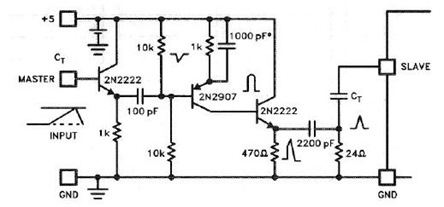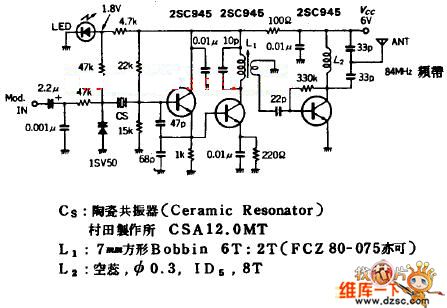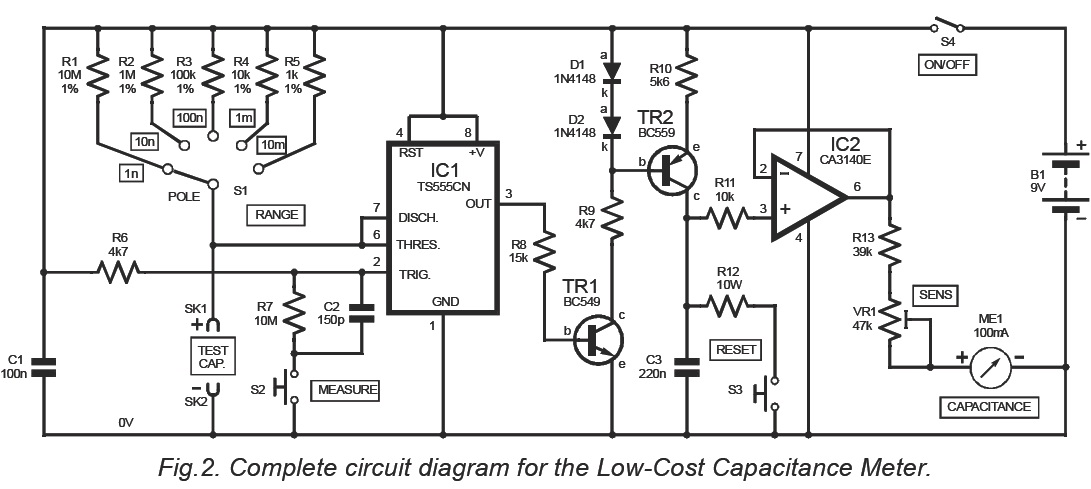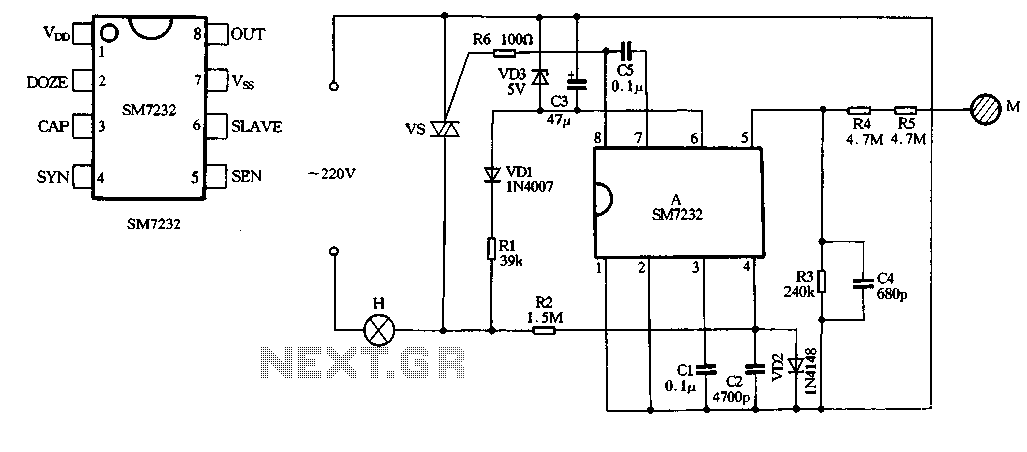
A Cmos Based Single Zone Alarm circuit
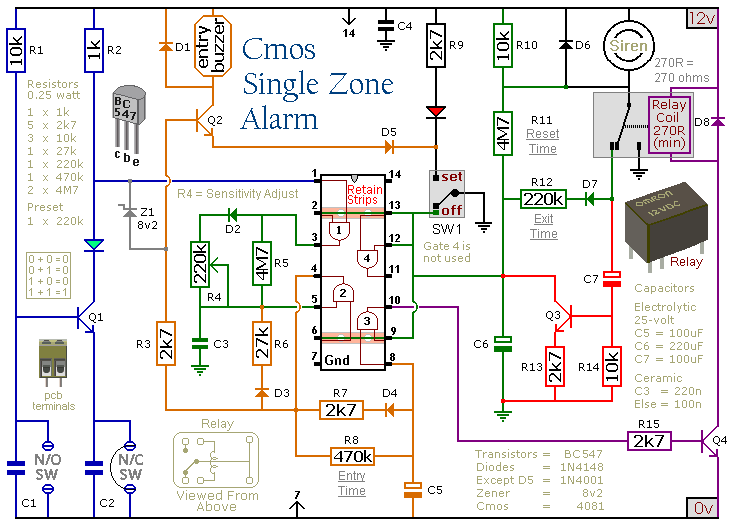
This circuit features automatic exit and entry delays, a timed bell cut-off, and a system reset. It accommodates both normally-open and normally-closed switches, making it compatible with various input devices such as pressure mats, magnetic reed contacts, foil tape, PIRs, and inertia sensors. If the green LED is not illuminated, check for an open window or other issues. Once the building is secured and the green LED is lit, move switch SW1 to the "set" position. At this point, the red LED will illuminate, and the exit delay will commence. The duration of the exit delay is determined by the value of resistor R12. With a 220k resistor, there will be approximately 30 to 40 seconds to exit the building. During this time, the buzzer will sound, ceasing when the door is closed, indicating that the trigger circuit has been restored within the allowed time. Upon returning to the building and opening the door, the buzzer will sound again, initiating the entry delay. The length of the entry delay is set by resistor R8. With a 470k resistor, there will be about 30 to 40 seconds to switch SW1 to the "off" position. Failure to do so will activate the siren, which will sound for a duration determined by resistor R11. With a 4M7 resistor, the siren will sound for approximately 15 to 20 minutes before the relay drops out, and the alarm attempts to reset itself. This reset is managed by transistor Q3, which briefly switches the alarm "off." If the trigger circuit is restored, the alarm will reset; otherwise, it will reactivate and continue attempts to reset every 15 to 20 minutes until the trigger circuit is restored or the alarm is turned off. Various triggering devices can be connected to the input terminals, including inertia sensors. The sensitivity of these sensors can be adjusted using resistor R4. When set to the minimum value, a light tap will activate the alarm; at maximum, a heavy blow is required. If inertia sensors are not utilized, R4 should be replaced with a 220k fixed resistor. If normally-open switches are not used, resistors R1, C1, and Q1 can be omitted, but a link must be added between the green LED and capacitor C2.
The circuit operates through a combination of resistors, capacitors, and transistors to manage the timing and functionality of the alarm system. The exit and entry delays are crucial for providing users with adequate time to leave and re-enter the building without triggering the alarm unintentionally. The use of a timed bell cut-off adds an additional layer of control, allowing users to silence the alarm after a period. The integration of both normally-open and normally-closed switches enhances flexibility, permitting various configurations based on user preference and specific application requirements.
The design should ensure that all components are rated appropriately for the voltages and currents they will encounter, particularly the resistors and the buzzer, which must handle the specified sound output without distortion. The inclusion of a transistor, such as Q3, for the reset function is critical for maintaining the integrity of the alarm system; it allows for a controlled reset process that minimizes false alarms while ensuring that the system remains vigilant.
The circuit layout should be organized to minimize interference and noise, especially in the areas where sensitive components like the inertia sensors are connected. Proper grounding and shielding techniques should be employed to protect against false triggering due to environmental factors. Overall, this alarm system design is robust and adaptable, making it suitable for a wide range of security applications.This circuit features automatic Exit and Entry delays - timed bell cut-off - and system reset. It has provision for normally-open and normally-closed switches - and will suit all of the usual input devices (Pressure Mats, Magnetic Reed contacts, Foil Tape, PIRs and Inertia-Sensors). If the green LED is not lighting - check for an open window or do or etc. Once you`re satisfied that the building is secure - and the green LED is lighting - move SW1 to the "set" position. At this point - the red LED will light - and the Exit Delay will begin. The length of the Exit Delay is set by the value of R12. With a 220k resistor - you have about 30 to 40 seconds to leave the building. As you do so - the Buzzer will sound. It should stop sounding when you close the door behind you. This indicates that the trigger circuit has been successfully restored within the time allowed. When you return to the building and open the door - the Buzzer will sound - and the Entry Delay will begin.
The length of the Entry Delay is set by the value of R8. With a 470k resistor- you`ll have about 30 to 40 seconds to move SW1 to the "off" position. If you fail to do so - the Siren will sound. The length of time the Siren sounds is set by R11. With a 4M7 resistor it will sound for about 15 to 20 minutes. Then the relay will drop out - and the alarm will attempt to reset itself. It does this by using Q3 to switch itself "off" briefly. If the trigger circuit has been restored - the alarm will reset. If not - the attempt will fail - and the alarm will reactivate. It will go on trying to reset itself every 15 to 20 minutes - until either the trigger circuit is restored - or the alarm is switched off. All the usual triggering devices may be connected to the input terminals. These include Inertia-Sensors. The sensitivity of the Sensors is adjusted by R4. Set to minimum value - a light tap will activate the alarm. Set to maximum value - a heavy blow is required. If you are not using Inertia Sensors - replace R4 with a 220k fixed resistor. If you are not using normally-open switches - you can leave out R1, C1 & Q1 - but you must fit an extra link between the Green Led and C2.
🔗 External reference
The circuit operates through a combination of resistors, capacitors, and transistors to manage the timing and functionality of the alarm system. The exit and entry delays are crucial for providing users with adequate time to leave and re-enter the building without triggering the alarm unintentionally. The use of a timed bell cut-off adds an additional layer of control, allowing users to silence the alarm after a period. The integration of both normally-open and normally-closed switches enhances flexibility, permitting various configurations based on user preference and specific application requirements.
The design should ensure that all components are rated appropriately for the voltages and currents they will encounter, particularly the resistors and the buzzer, which must handle the specified sound output without distortion. The inclusion of a transistor, such as Q3, for the reset function is critical for maintaining the integrity of the alarm system; it allows for a controlled reset process that minimizes false alarms while ensuring that the system remains vigilant.
The circuit layout should be organized to minimize interference and noise, especially in the areas where sensitive components like the inertia sensors are connected. Proper grounding and shielding techniques should be employed to protect against false triggering due to environmental factors. Overall, this alarm system design is robust and adaptable, making it suitable for a wide range of security applications.This circuit features automatic Exit and Entry delays - timed bell cut-off - and system reset. It has provision for normally-open and normally-closed switches - and will suit all of the usual input devices (Pressure Mats, Magnetic Reed contacts, Foil Tape, PIRs and Inertia-Sensors). If the green LED is not lighting - check for an open window or do or etc. Once you`re satisfied that the building is secure - and the green LED is lighting - move SW1 to the "set" position. At this point - the red LED will light - and the Exit Delay will begin. The length of the Exit Delay is set by the value of R12. With a 220k resistor - you have about 30 to 40 seconds to leave the building. As you do so - the Buzzer will sound. It should stop sounding when you close the door behind you. This indicates that the trigger circuit has been successfully restored within the time allowed. When you return to the building and open the door - the Buzzer will sound - and the Entry Delay will begin.
The length of the Entry Delay is set by the value of R8. With a 470k resistor- you`ll have about 30 to 40 seconds to move SW1 to the "off" position. If you fail to do so - the Siren will sound. The length of time the Siren sounds is set by R11. With a 4M7 resistor it will sound for about 15 to 20 minutes. Then the relay will drop out - and the alarm will attempt to reset itself. It does this by using Q3 to switch itself "off" briefly. If the trigger circuit has been restored - the alarm will reset. If not - the attempt will fail - and the alarm will reactivate. It will go on trying to reset itself every 15 to 20 minutes - until either the trigger circuit is restored - or the alarm is switched off. All the usual triggering devices may be connected to the input terminals. These include Inertia-Sensors. The sensitivity of the Sensors is adjusted by R4. Set to minimum value - a light tap will activate the alarm. Set to maximum value - a heavy blow is required. If you are not using Inertia Sensors - replace R4 with a 220k fixed resistor. If you are not using normally-open switches - you can leave out R1, C1 & Q1 - but you must fit an extra link between the Green Led and C2.
🔗 External reference


